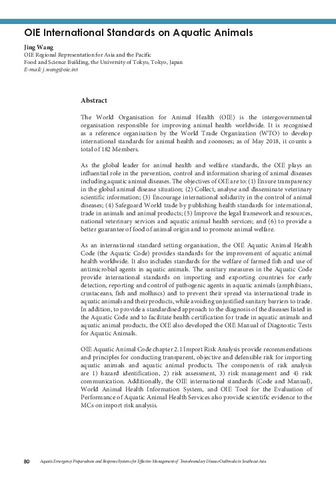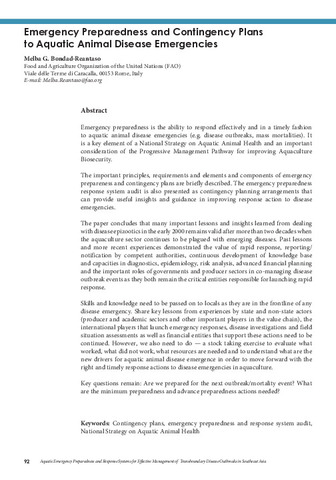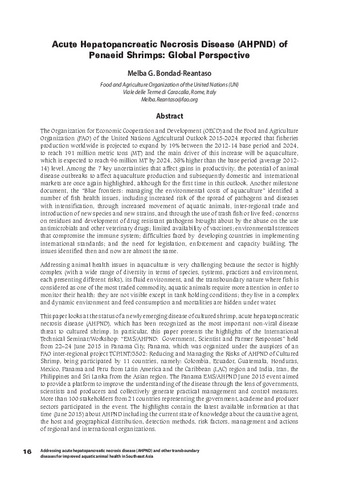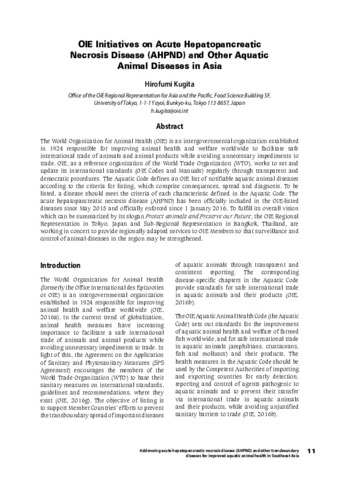OIE international standards on aquatic animals
Share
Abstract
The World Organisation for Animal Health (OIE) is the intergovernmental organisation responsible for improving animal health worldwide. It is recognised as a reference organisation by the World Trade Organization (WTO) to develop international standards for animal health and zoonoses; as of May 2018, it counts a total of 182 Members.
As the global leader for animal health and welfare standards, the OIE plays an influential role in the prevention, control and information sharing of animal diseases including aquatic animal diseases. The objectives of OIE are to: (1) Ensure transparency in the global animal disease situation; (2) Collect, analyse and disseminate veterinary scientific information; (3) Encourage international solidarity in the control of animal diseases; (4) Safeguard World trade by publishing health standards for international, trade in animals and animal products; (5) Improve the legal framework and resources, national veterinary services and aquatic animal health services; and (6) to provide a better guarantee of food of animal origin and to promote animal welfare.
As an international standard setting organisation, the OIE Aquatic Animal Health Code (the Aquatic Code) provides standards for the improvement of aquatic animal health worldwide. It also includes standards for the welfare of farmed fish and use of antimicrobial agents in aquatic animals. The sanitary measures in the Aquatic Code provide international standards on importing and exporting countries for early detection, reporting and control of pathogenic agents in aquatic animals (amphibians, crustaceans, fish and molluscs) and to prevent their spread via international trade in aquatic animals and their products, while avoiding unjustified sanitary barriers to trade. In addition, to provide a standardised approach to the diagnosis of the diseases listed in the Aquatic Code and to facilitate health certification for trade in aquatic animals and aquatic animal products, the OIE also developed the OIE Manual of Diagnostic Tests for Aquatic Animals.
OIE Aquatic Animal Code chapter 2.1 Import Risk Analysis provide recommendations and principles for conducting transparent, objective and defensible risk for importing aquatic animals and aquatic animal products. The components of risk analysis are 1) hazard identification, 2) risk assessment, 3) risk management and 4) risk communication. Additionally, the OIE international standards (Code and Manual), World Animal Health Information System, and OIE Tool for the Evaluation of Performance of Aquatic Animal Health Services also provide scientific evidence to the MCs on import risk analysis.
Suggested Citation
Wang, J. (2019). OIE international standards on aquatic animals. In E. A. Tendencia, L. D. de la Peña, & J. M. V. de la Cruz (Eds.), Aquatic Emergency Preparedness and Response Systems for Effective Management of Transboundary Disease Outbreaks in Southeast Asia: Proceedings of Asean Regional Technical Consultation, 20-22 August 2018, Centara Grand Central Ladprao, Bangkok, Thailand (p. 80). Tigbauan, Iloilo, Philippines: Aquaculture Department, Southeast Asian Fisheries Development Center.
Subject
disease control  ; disease recognition
; disease recognition  ; disease resistance
; disease resistance  ; disease transmission
; disease transmission  ; epidemiology
; epidemiology  ; husbandry diseases; aquaculture regulations
; husbandry diseases; aquaculture regulations  ; quarantine regulations
; quarantine regulations  ; fish culture
; fish culture  ; fish diseases
; fish diseases  ; standards
; standards  ; aquatic animals
; aquatic animals  ; aquatic organisms
; aquatic organisms  ; animal diseases
; animal diseases  ; fishery organizations
; fishery organizations  ; international organizations
; international organizations  ; analysis
; analysis  ; information systems
; information systems  ; fish
; fish  ; trade organizations
; trade organizations  ; aquatic crustaceans
; aquatic crustaceans  ; organizations
; organizations  ; communication
; communication  ; risk management
; risk management  ; aquatic reptiles
; aquatic reptiles  ; trade
; trade  ; risk
; risk  ; control methods
; control methods  ; animal welfare
; animal welfare  ; pathogens
; pathogens  ; detection
; detection  ; world
; world  ; animal products
; animal products  ; products
; products 
 ; disease recognition
; disease recognition  ; disease resistance
; disease resistance  ; disease transmission
; disease transmission  ; epidemiology
; epidemiology  ; husbandry diseases; aquaculture regulations
; husbandry diseases; aquaculture regulations  ; quarantine regulations
; quarantine regulations  ; fish culture
; fish culture  ; fish diseases
; fish diseases  ; standards
; standards  ; aquatic animals
; aquatic animals  ; aquatic organisms
; aquatic organisms  ; animal diseases
; animal diseases  ; fishery organizations
; fishery organizations  ; international organizations
; international organizations  ; analysis
; analysis  ; information systems
; information systems  ; fish
; fish  ; trade organizations
; trade organizations  ; aquatic crustaceans
; aquatic crustaceans  ; organizations
; organizations  ; communication
; communication  ; risk management
; risk management  ; aquatic reptiles
; aquatic reptiles  ; trade
; trade  ; risk
; risk  ; control methods
; control methods  ; animal welfare
; animal welfare  ; pathogens
; pathogens  ; detection
; detection  ; world
; world  ; animal products
; animal products  ; products
; products 
Related items
Showing items related by title, author, creator and subject.
-
Emergency preparedness and contingency plans to aquatic animal disease emergencies
Bondad-Reantaso, Melba G. (Aquaculture Department, Southeast Asian Fisheries Development Center, 2019)Emergency preparedness is the ability to respond effectively and in a timely fashion to aquatic animal disease emergencies (e.g. disease outbreaks, mass mortalities). It is a key element of a National Strategy on Aquatic ... -
Acute hepatopancreatic necrosis disease (AHPND) of penaeid shrimps: Global perspective
Bondad-Reantaso, Melba G. (Aquaculture Department, Southeast Asian Fisheries Development Center, 2016)The Organization for Economic Cooperation and Development (OECD) and the Food and Agriculture Organization (FAO) of the United Nations Agricultural Outlook 2015-2024 reported that fisheries production worldwide is projected ... -
OIE initiatives on acute hepatopancreatic necrosis disease (AHPND) and other aquatic animal diseases in Asia
Kugita, Hirofumi (Aquaculture Department, Southeast Asian Fisheries Development Center, 2016)The World Organization for Animal Health (OIE) is an intergovernmental organization established in 1924 responsible for improving animal health and welfare worldwide to facilitate safe international trade of animals and ...




